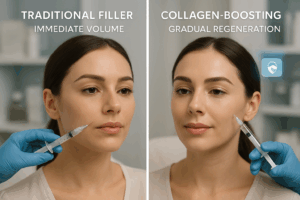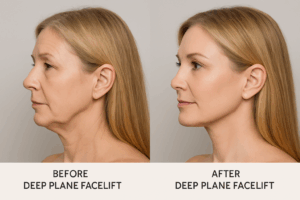Fat Grafting, also known as fat transfer or fat injections, is a surgical technique that involves transferring fat from one part of the body to another. This procedure is primarily used for cosmetic enhancement and reconstructive purposes, offering a natural solution for volume restoration and contouring. Let’s delve into the different types of fat used in grafting: regular fat, micro fat, and nano fat.
What is Fat Grafting?
Fat grafting is a process where fat is harvested from a donor site on the patient’s body, typically through liposuction, and then injected into the desired area. This technique is favored for its biocompatibility and ability to provide natural-looking results without the risk of allergic reactions, as the fat is autologous (from the patient’s own body)[2].
Types of Fat Used in Grafting
Macro Fat or Regular Fat
Macro fat, or regular fat’s the traditional form of fat used in grafting. It involves transferring larger particles of fat, which can be used to add significant volume to areas like the breasts, buttocks, or cheeks. This method is effective for substantial volume enhancement but can sometimes lead to lumpiness if not performed with precision.
Micro Fat
Micro fat grafting involves the use of smaller fat particles, allowing for more precise contouring and volume restoration in delicate areas such as the face, hands, and under-eye regions. The smaller particle size reduces the risk of irregularities and provides a smoother appearance. This technique is particularly useful for facial rejuvenation, offering subtle yet effective results[4].
Nano Fat
Nano fat grafting takes the process a step further by breaking down fat into even smaller particles, almost to the point where they no longer provide volume. Instead, nano fat is rich in stem cells and growth factors, which can rejuvenate and improve the quality of the skin. It is commonly used to address fine lines, skin texture, and discoloration, offering regenerative benefits without adding bulk[4].
Applications and Benefits of Fat Grafting
- Facial Rejuvenation: Fat grafting is widely used for facial rejuvenation, helping restore youthful contours and improve skin quality. Micro and nano fat are particularly effective in this area due to their ability to refine details and enhance skin health[3][4].
- Breast and Body Contouring: Regular fat grafting is often employed in breast augmentation and body contouring, providing a natural alternative to implants and fillers.
- Scar and Skin Repair: Nano fat’s regenerative properties make it a valuable tool for improving scars and enhancing skin texture, leveraging the healing potential of stem cells[4].
Conclusion
Fat grafting is a versatile and evolving technique in cosmetic and reconstructive surgery. By understanding the distinctions between regular fat, micro fat, and nano fat, patients and practitioners can better tailor treatments to achieve desired outcomes. I can increase volume, help shape contour, improve skin quality, and more with different types of fat grafting, anatomic areas of placement, and more.
Fat grafting continues to offer promising results with minimal risk of complications. As research and technology advance, the applications and efficacy of fat grafting are expected to expand, providing even more refined and effective solutions in the field of aesthetic medicine.




Recent Comments